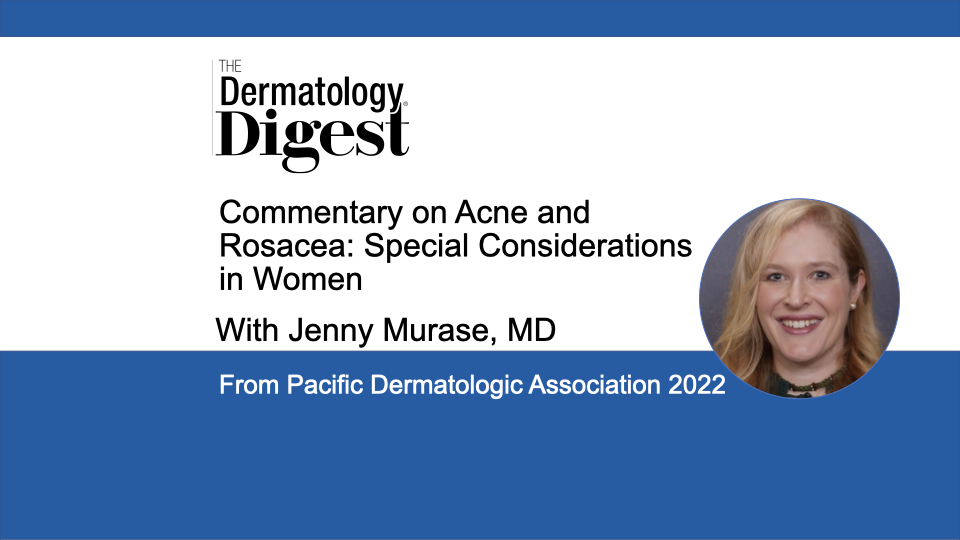Dr. Murase discusses how to safely and effectively manage acne and rosacea in adult female patients, including special considerations for pregnancy and lactation.
Jenny Murase, MD, Associate Clinical Professor at University of California San Francisco (UCSF) and Director of Medical Consultative Dermatology at the Palo Alto Foundation Medical Group, Mountain View, California
“Acne and rosacea in the older female patient, over the age of 25, can be more difficult to manage given the very high treatment failure rate. In general, patients that are the most frustrated are those in their 30s and 40s who may not have had acne in their teenage years but are suddenly getting nodulocystic acne in their jawline,” said Jenny Murase, MD, who presented “Acne and Rosacea: Special Considerations in Women” at the Pacific Dermatologic Association (PDA) 2022 meeting, in Portland, Oregon.
“They can also have small comedones covering their forehead. Those are the classic features of androgen excess acne presentation.”
These patients often have failed multiple courses of systemic antibiotics and about a third of the time
the acne or rosacea relapses after oral isotretinoin, according to Dr. Murase.
“Hormonal therapy, in particular, can be a very good long-term safe and effective therapy if the patient is over the age of 14. It has been shown to have equivalent efficacy to oral antibiotics after six months. In the first six months, antibiotics may be superior….”
About Hormonal Testing
While there often is a hormonal component when adult females present with acne or rosacea, Dr. Murase said hormonal testing generally isn’t necessary unless the dermatologist suspects hyperandrogenism. Clinical scenarios in which to consider a hormonal workup for hyperandrogenism include if the patient presents with hirsutism, early onset androgenetic alopecia, infertility, or oligomenorrhea or amenorrhea. Another sign is sudden or severe onset of acne, she said.
“Certainly, if there is virilization, where there is a deepening of the voice or an increase in muscular habitus, that would also be a very strong indication for a workup for hyperandrogenism through laboratory tests.”
The most common scenario that a dermatologist would likely see is a patient with polycystic ovary syndrome (PCOS), said Dr. Murase.
“In general, the essential labs for hyperandrogenism include testosterone (total). If it’s a really marked elevation of over 200 for total testosterone, that’s suggestive of an ovarian tumor. We also do 17-hydroxyprogesterone for congenital adrenal hyperplasia. And we can do a [dehydroepiandrosterone sulfate] DHEAS level. If it’s very high that would imply an adrenal tumor or congenital adrenal hyperplasia.”
Labs that can be helpful in the workup for hyperandrogenism include luteinizing hormone/follicle stimulating hormone (LH-FSH). A 3-to-1 ratio or greater would be suggestive for PCOS, said Dr. Murase.
“We will order a prolactin level for a pituitary tumor evaluation, and a sex hormone binding globulin (SHBG) because we want to see if this is increased. Interestingly this is inversely related to development of type 2 diabetes in older patients, so other relevant labs can include screening for diabetes with a fasting insulin and looking for things like metabolic syndrome, which often accompanies hyperandrogenism.”
The best time to do any kind of hormonal workup, according to Dr. Murase, is the third day of menses in early morning, 6 weeks or more after stopping hormonal therapy.
Pregnancy and Lactation Considerations
In terms of therapy for the pregnant patient, first-line therapy for acne and rosacea would be in the amoxicillin or cephalosporin class, said Dr. Murase.
“Classically, I use amoxicillin for an acne rosacea patient and cefadroxil for an acne vulgaris patient.”
Dermatologists often think erythromycin is the drug of choice but that is not the case, according to Dr. Murase.
“Erythromycin is a second-line therapy if you do need to prescribe antibiotics for a severe cystic acne patient or a patient with severe papulopustular rosacea that may result in scarring. The reason erythromycin is a second-line choice is that there is an increased risk of atrial/ventricular septal defects, as well as pyloric stenosis, if there is first trimester use of erythromycin. Erythromycin estolate has been associated with an increase in liver function tests, in particular AST levels in the second trimester and that occurs in about 10% of cases and it is reversible. But erythromycin ethylsuccinate and erythromycin base do not have this risk.”
Clindamycin also is safe in pregnancy, said Dr. Murase.
“We do not prescribe the tetracyclines in the second and third trimesters. But if you have a complicated infection, tetracycline would be acceptable, as well as sulfonamides and trimethoprim, for third-line choices in very specific situations.”
All of the topical acne therapies are safe in pregnancy, including clindamycin, azelaic acid, and metronidazole. Topical tretinoin also is likely safe in pregnancy, she said.
“The percutaneous absorption of topical tretinoin is very low, at 1% to 2% and the plasma concentrations aren’t changed after one month of use.”
In terms of lactation, the vast majority of oral antibiotics are considered safe in a lactating patient.
“We do recommend avoiding long-term use of trimethoprim-sulfamethoxazole or the tetracyclines. You do want to avoid using erythromycin for a newborn because there is an association between breastfeeding and the development of pyloric stenosis. But if the baby is older than 4 months of age, erythromycin is an acceptable second-line therapy.”
Disclosure: Dr. Murase reports no relevant conflicts.


